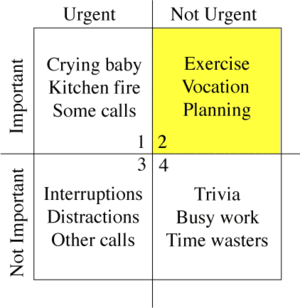This is an interesting post about how the tools we use to help make our lives much easier

- time management matrix
can sometimes add to the frustration and work load in our lives if we don’t use the tools correctly. Time management is no exception to this rule. There are many powerful time management tools out there than can really help effectively manage our time, but they can also drive us down the rabbit hole as well if we are not careful. Read on for more about how time management tools can wast our time if not used effectively.
Are you managing your time efficiently? Or do you often find out that the time lost in working on your time management is more than the time saved from it? This is by far the biggest risk, along with losing money on bad tools or bad time management training.
Remember:
The point of time management is to improve the way you use your time, free up your brain from unimportant tasks, and free you up from stress. If instead of this your efforts to manage time end up in less time for you and more stress, you are obviously on the wrong way.
Tools and software can help you a lot to control your time better. Instead of having to remember activities and techniques, time management tools help you automate them. But… sometimes there is a risk. Let’s explore three major types of tools and the risks associated with them:
Low Risk: Calendars
Calendars help you organize your events, meetings, dates, important milestones and other duties. They help you not to miss your visit at the dentist and can remind your friends to come at the party tomorrow. Many calendars are free and have nice features like email reminders, sending iCal invites and so on. Calendars are very useful time management tools and you should use them. But use them properly, because otherwise they can get you in trouble too.
The main risk with calendars is to rely too much on yours. If you expect your calendar to know your appointments better than you (which is it’s purpose anyway), what happens when it doesn’t work well? What happens for example if you rely on receiving email reminder about an appointment but exactly this time the email arrives in your spam box? Such events are rare and that’s what makes them so unexpected.
You should never rely 100% on technologies. If an event is important for you, insert it in 2 or 3 calendars, put it in your phone alarm, use the good old method with paper and fridge magnet.
Medium Risk: To do lists
To do lists are neat little apps that let you create projects, assign tasks to them, reorder them, and mark them done when done. While bloody simple, these apps are very useful for time management. They help you not forget the tasks you have. They help you write your ideas as tasks in very simple way. They help you watch how you accomplish a project. Very nice!
What’s so risky about them? Just think a little. What happens with the tasks that you forget to write in the list? I’ll tell you. They never get done.
Then what happens with the not-so-easy tasks? I’ll tell you. They never get done, because you always move them after the others and if by any chance they remain the last in the list, you come up with new ideas and new tasks.
And finally, when your to-do list becomes too large, it causes the decision block. How to order the tasks, which ones to do first? When you have a long task list you can easily feel depressed and lose your motivation.
But don’t get me wrong, to do lists are great tools when used right…
High Risk: Time management charts
Time management charts are supposed to help you visualize how you spend your time, figure out the time wasters, and figure out which activities you do in your most productive time. They can be extremely powerful in giving long term results by helping you organize your daily routines and productive time better.
They can also lead to extreme time waste if not used correctly. Imagine what happens if you underestimate the importance of proper tracking and enter values in the chart “as you feel them”. Generally you will decrease the time spend to time wasters (think checking your Facebook account), because you don’t feel them as wasters. At the end the time management chart will show totally misleading information.
Another even more common risk is just to spend too much time maintaining your time management chart and then get no useful results. You don’t need another addiction – if you can get useful results from using time management charts in a couple of weeks, drop using them for good.
Don’t forget that time management tools are created to help you and they will, if you use them well. And if you combine them with the best time management activities you will be the master of your time!
Incoming time management related search terms:
- risk management matrix of
- time management strategies
- time management tools for adults
- time management tools - email
- time management tools
- time management tool
- what happens when time management doesn\t work
- Theses time management
- management
- how is time management used correctly yahoo
Related posts:
- Effective Tools for Time Management Tracking Although this author violates my #3 commandment of article writing in terms of not linking to things that have no...
- Time Management Strategies for Getting Organized This is a good article for giving people great strategies for managing their time. If you want to build additional...
Tags: Calendar, Time Tracking, to-do lists
